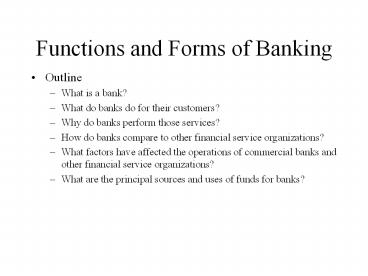Functions and Forms of Banking - PowerPoint PPT Presentation
1 / 11
Title:
Functions and Forms of Banking
Description:
How do banks compare to other financial service organizations? ... Banks are pooling loans for various kinds and selling securities with claims on these loans. ... – PowerPoint PPT presentation
Number of Views:100
Avg rating:3.0/5.0
Title: Functions and Forms of Banking
1
Functions and Forms of Banking
- Outline
- What is a bank?
- What do banks do for their customers?
- Why do banks perform those services?
- How do banks compare to other financial service
organizations? - What factors have affected the operations of
commercial banks and other financial service
organizations? - What are the principal sources and uses of funds
for banks?
2
What is a bank?
- In the U.S. a bank is defined by federal and
state laws and by bank regulators. - National Currency Act of 1863 created the OCC and
said a national bank will carry out the
business of banking. - Bank Holding Company Act of 1956 changed the
definition to accepting deposits that can be
withdrawn on demand and making commercial loans. - Competitive Equality Banking Act of 1987
broadened definition to accepting deposits and
making loans. - Today a legal definition is that a bank makes
loans, has insured FDIC deposits, and has banking
powers under state and federal government laws.
3
What is a bank?
- Types of banks
- Global, international banks or money center banks
- Medium and large size banks that are full-service
banks (but not universal banks as in Europe and
some other foreign countries) - Small and medium size banks that are retail or
consumer banks (which use correspondent banks and
outsourcing) - Banks that focus on medium and large business
firms or wholesale banks (which also includes
limited purpose banks that are further
specialized in terms of customer base)
4
What do banks do for their customers?
- Payments
- These services include coin and currency and
financial transactions, including checking
accounts, credit cards, electronic banking (CHIPS
or Clearing House Interbank Payments System),
wire transfers (Fedwire), international payments
(SWIFT or Society for Worldwide Interbank
Financial Telecommunication), etc. - Retail payments system and large-dollar payments
system for business and government
5
What do banks do for their customers?
- Financial intermediation
- Deposit function of offering savers a wide
variety of denominations, interest rates, and
maturities, as well as risk-free (FDIC insured)
deposits and a high degree of liquidity. - Loan function of transferring or allocating
savings to most productive and profitable uses to
provide growth and stability of the economy. - Other financial services include off-balance
sheet risk taking (from financial derivatives and
guarantees), insurance-related activities,
securities-related services, and trust services.
6
Why do banks perform those services?
- Banks are private firms with a public purpose.
They seek to maximize shareholder wealth
(represented by the market value of bank stock
and dividends paid). - Banking is the management of risk. By taking
risks, they earn a profit. - -- Credit risk -- Foreign exchange risk
- -- Interest rate risk -- Compliance risk
- -- Liquidity risk -- Strategic risk
- -- Price risk -- Reputation risk
- Various factors that affect banks include include
market, social, and legal and regulatory
constraints.
7
How do banks compare to other financial service
organizations?
- Banks are the dominant financial institution in
the U.S. based on the percentage of total assets
(24). - Federally related mortgage pools are second
largest (12). - Life insurance are third largest (11).
- Other significant organizations include savings
institutions, money market funds, mutual funds,
and asset-backed security issuers. - However, commercial banks shrank from 34 in 1980
to 24 in 1997.
8
What factors have affected the operations of
commercial banks and other financial service
organizations?
- Inflation and volatile interest rates
- Rising interest rates caused shorter-term deposit
costs to rise faster than longer-term loans.
Also, as rates rose, the market value of their
assets declined and borrowers defaulted on loans
with greater frequency than normal. - Securitization
- Banks are pooling loans for various kinds and
selling securities with claims on these loans. - Technological advances
- Telecommunications and computers are increasing
economies of scale and economies of scope for
banks.
9
What factors have affected the operations of
commercial banks and other financial service
organizations?
- Consumers have become more sophisticated.
- Capital markets have increased their competition
with banks in attracting firms seeking debt
funds. - Deregulation
- The elimination of laws that placed geographic
limits on banks, their products and services, and
the rates they can pay has stimulated bank
mergers and consolidation in the banking industry
(e.g., 14,400 banks in 1985 compared to 8,500
banks in 2000). - Despecialization and competition among financial
institutions with one-stop shopping centers. - Global integration of financial markets is
increasing competition from foreign financial
service firms.
10
What are the principal sources and uses of funds
for banks?
- Assets
- Loans
- commercial and industrial (CI) loans
- real estate loans
- consumer loans
- Investments
- short-term, liquid securities (e.g., U.S.
Treasury securities) - long-term securities
- Cash
- Other assets
- buildings, equipment, etc.
11
What are the principal sources and uses of funds
for banks?
- Liabilities
- Deposits
- transactions deposits
- nontransactions deposits
- Nondeposit sources of funds
- Equity
- Relatively small compared to debt sources of
funds. Highly leveraged compared to nonfinancial
firms.































